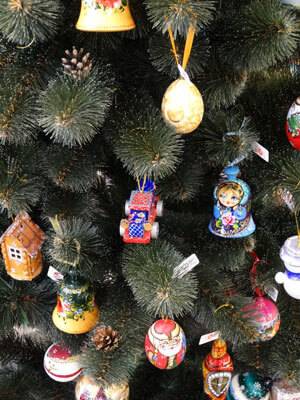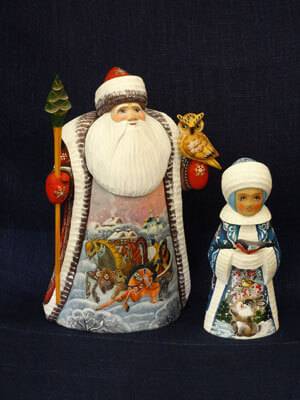
A souvenir (from French, for a remembrance or memory) is something that a person buys or gets for the memories the owner associates with it.
Russia is famous for its handicrafts. So what would be a good gift to bring back from Russia?
Matryoshka (Nesting dolls)
The first Russian Matryoshka was created at the Abramtsevo Estate near Moscow in 1890 in the workshop called “Children’s Education.” The owner of the estate was Savva Mamontov, who was a patron of arts. At the end of the 19th century there was a widely spread idea, maybe even a passion among artists to create a new Russian style. Mamontov was one of the first to patronize artists who were working on this new style.
Once somebody brought a funny Japanese figure of a bald head old man called a Fukuruma. The doll had some other dolls nested one into the other, 7 altogether. According to the legend, an unknown Russian monk created the first doll of this kind on Honshu Island. Actually, such type of nesting dolls did exist in Russia long ago, Russian craftsmen used this method to make nested Easter eggs.
Russian nesting dolls made of wood with smaller dolls inside are called matryoshka. Matryona or Matryoshka used to be a very popular female name among peasants in old Russia. This name has a Latin root «mater» meaning «mother». Therefore, the doll is associated with the image of a Russian mother with a big family.
There different kinds of matryoshka dolls and the price varies depending on the size of the doll and the amount of work. You can get a very simple one, which will be rather cheap, or a hand-painted big matryoshka the price of which can easily come up to hundreds of dollars.
Amber
Baltic amber has always been well-known around-the-world. However when the famous Amber Room was opened to the public in 2003 interest in amber grew significantly.

Amber from the Baltics constitutes approximately 80% of the world’s amber. It is mined along the southern coast of the Baltic Sea: in Estonia, Latvia, Lithuania, Poland, Germany – and in Kaliningrad district in Russia. By the way, the original Amber Room was created using amber mined in Kaliningrad, which at that time was German territory and was called Königsberg.
Amber is not really a stone, it is resin from the trees that used to grow in Scandinavia before the Ice Age. It took millions of years for amber to become stone – nothing compared to the life of a human being.

In the shops you can find amber of all different colors – starting from a familiar yellowish one and finishing with deep red and greenish. There is not just jewelery with amber, but also useful objects like ashtrays or business card holders.
Many people know about insects that can be entombed in amber. Naturally, such stones are more expensive. However, most amber pieces with insects you find in shops have been manufactured. Usually amber is real amber, but insects are fake.
You can find amber in most souvenir stores, but it is better to buy it indoors. There you can always ask for a certificate of quality for the piece you are buying.
Lacquer boxes
This is one more very important and world-famous Russian handicraft. The boxes are made of papier-mache and it takes about a month to create one box, no wonder that the price is about one hundred dollars for a rather small piece!

This art has been known in Russia since the late 18th century and the production has not changed significantly since the mid-19th century.
There are four main schools of lacquer box production in Russia: Fedoskino, Kholui, Mstera and Palekh. Each school has its own significant features and traditions. On the original box you can always find the name of the school, the name of the painting, and the name of the artist.
Fedoskino is the oldest school. Lacquer miniatures of Fedoskino are very realistic. The theme of troika-riding was most widespread in the 19th century miniatures. A troika rushing through the forests full of snow and sleigh riders is a popular theme that has become a symbol of this art. The most famous theme among Fedoskino artists is the Russian fairy tales.
Kholui is another well-known school. The miniatures of this school are decorative and realistic, and they focus on portrayal of the personality. Artists of Kholui love to paint Biblical and Gospel themes. Their work is distinguished from the other schools because of the color scheme. In Kholui masters like bluish-greenish and yellowish-brown colors.
Works by masters from Mstera are somewhat like carpets. They are extremely decorative, diverse, and exquisite, but the color scheme usually features one color with a variety of shades and hue. Predominant colors are bluish-silver, red and yellow. Among subjects you can find genre scenes, historical and architectural monuments.
Palekh School features representations of scenes taken from everyday life including works by the classics of Russian literature, fairy tales and fables. Usually the miniature is made in tempera on a black background with usage of leaf gold.
Any lacquered box is a beautiful gift!
Faberge Style Eggs
Carl Faberge created his first Easter egg for Alexander III in 1885. Since that time until the October Revolution in 1917 50 eggs for the Imperial Russian family have been created along with many more for other members of the so-called “high society.” Nowadays nine eggs are exhibited in the Faberge Museum in St Petersburg.

When coming to Russia many people acquire Faberge style eggs or pendants as souvenirs.
Faberge Easter eggs were created from silver, gold, and enamels with the usage of rubies, emeralds, pearls and diamonds. The ones you find in shops are usually made of metals, enamel and Swarovski crystals. Some are made to look like full-size copies of the original eggs; others are just made in the style. There are also eggs made of silver with semi-precious stones, but these are more expensive.
Pendants and earrings in Faberge style are also available in most shops.
New Year and Christmas Gifts

Russian Christmas is celebrated on January 7th per the Orthodox Church. New Year is a much more popular holiday. And instead of Santa Claus we have Father Frost (Ded Moroz) and his granddaughter the Snow Maiden (Snegurochka).

Their representations carved out of wood, hand painted, and lacquered will be an excellent gift at any time of the year as a reminder of the famous Russian winters.
Headscarves (babushkas)
Traditionally such scarves are produced in Russia near Moscow in the town called Pavlovsky Posad. The pattern usually represents flowers and bouquets of flowers, which is considered to be traditionally Russian.
Russian Porcelain

Porcelain came to Europe from China and was extremely expensive. It was only in the early 18th century that people in Europe understood how to make their own porcelain. Meissen, Sevres, and Wedgewood are the most well-known porcelain centers of Europe.
The Imperial Porcelain Factory in St Petersburg was established in 1744. It produced exquisite porcelain pieces. During the Soviet period it was named after an outstanding Russian scientist as the Lomonosov Porcelain Factory. Nowadays it is once again Imperial Porcelain and there are many shops around St Petersburg where you can get fine pieces of Russian porcelain.
The most recognizable pattern of porcelain from St Petersburg is the so-called cobalt net. The design was invented in 1945, just after the WWII, and soon became the brand of the factory. You can easily find pieces of porcelain decorated with this pattern in most shops of the city. They say coffee tastes better when you drink it from a cup made of fine Russian porcelain!
Books

Among one of the most useful souvenirs – how about a book? In souvenir stores there are books in English about the city, the Tsar’s, the Hermitage Museum – we of course visit the museum, but even half a day in not enough to cover everything! In this case a book could be a wonderful gift with reproductions of the best masterpieces and explanations of artwork in the Hermitage. It will also be of use when you decide to freshen up your memories of the trip!
You have probably heard about Alexander Pushkin, the greatest Russian poet. We sometimes call him “the Russian Byron.” Unfortunately, his poems are almost impossible to translate into other languages, but the opera “Eugene Onegin” by Tchaikovsky was written after the novel by Pushkin and it is rather well-known abroad. However Pushkin also created fairy tales for children, and these you can find in most widely-spoken languages of the world in our stores in St Petersburg. It will be an excellent gift for small children and in this way they will be able to learn more about mysterious Russia!
During our St Petersburg tours and shore excursions we always leave some time for shopping. Our guides will help you to find the best place to enjoy good quality gifts at a reasonable price!
